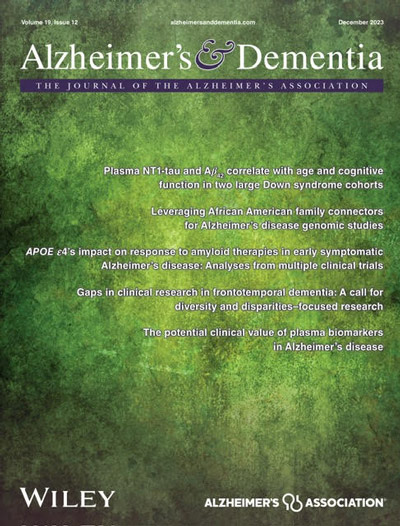Assessing polyomic risk to predict Alzheimer's disease using a machine learning model
IF 13
1区 医学
Q1 CLINICAL NEUROLOGY
引用次数: 0
Abstract
INTRODUCTIONAlzheimer's disease (AD) is the most common form of dementia in the elderly. Given that AD neuropathology begins decades before symptoms, there is a dire need for effective screening tools for early detection of AD to facilitate early intervention.METHODSHere, we used tree‐based and deep learning methods to train polyomic prediction models for AD affection status and age at onset, employing genomic, proteomic, metabolomic, and drug use data from UK Biobank. We used SHAP to determine the feature's importance.RESULTSOur best‐performing polyomic model achieved an area under the receiver operating characteristics curve (AUROC) of 0.87. We identified GFAP and CXCL17 proteins to be the strongest predictors of AD, besides利用机器学习模型评估多基因组风险以预测阿尔茨海默病
简介阿尔茨海默病(AD)是最常见的老年痴呆症。鉴于老年痴呆症的神经病理学始于症状出现前的几十年,因此迫切需要有效的筛查工具来早期检测老年痴呆症,以便及早干预。方法在此,我们采用基于树和深度学习的方法,利用英国生物库的基因组、蛋白质组、代谢组和药物使用数据,训练老年痴呆症亲和力状态和发病年龄的多组预测模型。我们使用 SHAP 来确定特征的重要性。结果我们表现最好的多组模型的接收者工作特征曲线下面积 (AUROC) 达到了 0.87。除了脂蛋白 E(APOE)等位基因外,我们还发现 GFAP 和 CXCL17 蛋白是预测 AD 的最强指标。通过纳入 "AD-by-proxy "病例来增加病例数并不能提高AD预测能力。讨论根据AUROC(接收者操作特征曲线下面积),在四种模式中,基因组学和蛋白质组学是信息量最大的模式。我们的数据表明,两种基于血液的生物标记物(胶质纤维酸性蛋白 [GFAP] 和 CXCL17)可能对早期症状前预测 AD 非常有效。亮点 我们开发了一个多组学模型,利用 EHR 中的全局组学和药物使用数据预测 AD 和发病年龄。除 APOE 等位基因外,我们还发现 GFAP 和 CXCL17 蛋白是预测 AD 的最强指标。如果在训练中使用 "AD-by-proxy "病例,并不能提高AD预测能力。蛋白质组学是对情感状态和 AAO 预测最有参考价值的方法。
本文章由计算机程序翻译,如有差异,请以英文原文为准。
求助全文
约1分钟内获得全文
求助全文
来源期刊

Alzheimer's & Dementia
医学-临床神经学
CiteScore
14.50
自引率
5.00%
发文量
299
审稿时长
3 months
期刊介绍:
Alzheimer's & Dementia is a peer-reviewed journal that aims to bridge knowledge gaps in dementia research by covering the entire spectrum, from basic science to clinical trials to social and behavioral investigations. It provides a platform for rapid communication of new findings and ideas, optimal translation of research into practical applications, increasing knowledge across diverse disciplines for early detection, diagnosis, and intervention, and identifying promising new research directions. In July 2008, Alzheimer's & Dementia was accepted for indexing by MEDLINE, recognizing its scientific merit and contribution to Alzheimer's research.
 求助内容:
求助内容: 应助结果提醒方式:
应助结果提醒方式:


